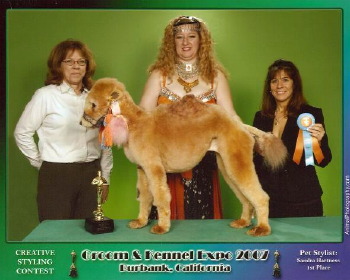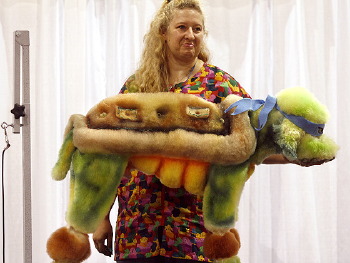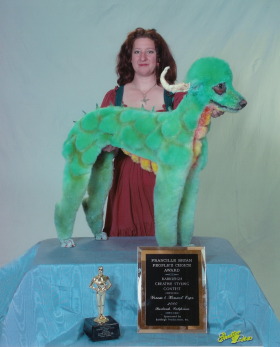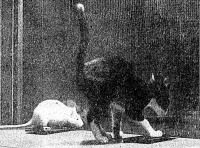Animals
Strange Russian Cartoon
If anyone has any idea what is going on in this cartoon, please tell the rest of us!Everytime I see a foreign cartoon like this, I am reminded of the parody of same once seen on The Simpsons.
Posted By: Paul - Sun Jan 18, 2009 -
Comments (3)
Category: Animals, Foreign Customs, Cartoons, Russia
Expensive Pets
Alex's post on animal owners seems to have divided WU readers into two camps: those who would pay any sum to heal their pet, and those who would duct-tape a gerbil at the first sign of infirmity.I'm sure both types of readers would like to learn about the experiences of Kim Cavallero.
Due to myriad health issues, Kim Cavallero has racked up more than $20,000 in veterinary bills for her cat, Annie, in the past year. Through the employee assistance program at her job, she discovered Feline Outreach. "During a time when people thought I was crazy for continuing to care for my pet through very serious and expensive medical care, Feline Outreach validated me -- especially emotionally,'' she said. "With their grant, they let me know that I was doing the right thing for my cat.''
Posted By: Paul - Mon Jan 12, 2009 -
Comments (12)
Category: Animals, Medicine, Money
The 5 Types of Annoying Pet Owners
Sociological research, detailed in a 1994 article in the journal Qualitative Sociology, reveals that veterinarians classify annoying pet owners into five different types. I suspect I would fall into the animal-nut category.Ignorant clients
"Some clients were so hopelessly ignorant of the basic requirements of animal caretaking that they were viewed with a sort of sad bemusement. Frequently, these owners were the focus of joking among the staff." Example: One client insisted that, because she had paid over $350 for her cat, it should be immune to fleas.
Inattentive and Demanding Clients
"Belligerent clients complained, disputed diagnoses, demanded special considerations, and generally did not behave in the compliant and appreciative manner deemed appropriate by the doctors."
Neglectful Clients
"Unlike the ideally compliant and realistic client, some owners were viewed negatively by the staff because their pets' physical condition indicated that they were neglectful of or indifferent to their animals' well-being, For the most part, the veterinarians maintained that this type of client was rare since the very fact that a person brought their animal for veterinary services demonstrated that he or she feels at least a minimal concern for the creature's health."
Over-Involved Clients (animal nuts)
"Over-involved clients were deemed troublesome because of the extra time and unnecessary attention that frequently had to be devoted to them. This client commonly provided the veterinarian with excessive and overly detailed information about his or her pet's condition and behavior, thus making it difficult for the doctor to determine what was actually going on with the animal... Not all 'animal-nuts' were defined as problems, however. Frequently, the vets recognized that people who are strongly attached to their animals were the prime consumers of their services."
Cost-Focused Clients
"Clients who were more worried about the cost of the service than they were about the welfare of the animal tended to be negatively evaluated, while those for whom money was a secondary issue were more positively defined as appropriately conscientious owners."
Posted By: Alex - Mon Jan 12, 2009 -
Comments (10)
Category: Animals
A Dog’s Life
Crying Dog - Funny blooper videos are here
Posted By: Paul - Thu Jan 08, 2009 -
Comments (5)
Category: Animals, Business, Advertising, Products, Sexuality, Cars
Guide to Bovine Reproduction
 There's a lot of good information to be found over at the Visual Guide to Bovine Reproduction. For instance,
There's a lot of good information to be found over at the Visual Guide to Bovine Reproduction. For instance, Estrus detection: "The cow that stands to be mounted is the cow in heat. Cows are bisexual, hence may be mounted by a bull or another cow. Standing to be mounted is the gold standard of estrus detection."
And also:
Cow Eating Placenta: "It is not uncommon for a cow to eat her fetal membranes. This may cause digestive problems. It is an old-wives tale that the fetal membranes contain hormones that will benefit uterine involution. Some believe that it is the instinct of the cow "remove the evidence" to discourage predators."
What I find strange is the design of the site. For some reason, you don't really expect a guide to bovine reproduction to have fancy scrolling menus.
Posted By: Alex - Mon Dec 29, 2008 -
Comments (7)
Category: Animals
Creative Grooming
The Sandy Paws Grooming Shop of Yucca Valley, CA has won many creative grooming awards. It's not hard to see why:


Posted By: Alex - Tue Dec 23, 2008 -
Comments (7)
Category: Animals
Cat-Rat Cooperation Disproves Darwin
 Chuck's post last week about the guy who trained a rat to sit on top of a cat sitting on a dog, reminded me of the groundbreaking research of Dr. Loh Seng Tsai, conducted back in the late 1940s/early 1950s.
Chuck's post last week about the guy who trained a rat to sit on top of a cat sitting on a dog, reminded me of the groundbreaking research of Dr. Loh Seng Tsai, conducted back in the late 1940s/early 1950s.Dr. Tsai trained a cat and a rat to cooperate together in order to get food. From the LA Times, July 15, 1951:
To get into the third section, where a dish of food awaits, the cat and mouse must each step on a floor button simultaneously. When this is done by perfect cooperation the gate drops and both animals thus gain admittance to the food chamber.
Dr. Tsai reported that, "Soon all the pairs of cats and rats began to work together. Finally their cooperation was so perfect that they took only three seconds to reach their food from the entrance."
Dr. Tsai figured that these results disproved Darwin's concept of the Survival of the Fittest. He told the LA Times reporter: "In the face of the fact that even alley cats and rats live together, eat together, sleep together, play together and work together, Darwin's theory seems at most only a half-truth."
What's really amazing is that this guy was a professor of biology at first the University of Chicago, then Tulane, then UCLA, and yet he didn't seem to have a clear understanding of what Darwin meant by the Survival of the Fittest. Nor, as far as I can tell, did anyone ever call him out as a crackpot. In fact, there was talk of nominating him for the Nobel Peace Prize.
Posted By: Alex - Tue Dec 23, 2008 -
Comments (6)
Category: Animals, Science, Experiments
Dr. Dove’s Unicorn Bull
 In 1933 Dr. W.F. Dove, a biologist at the University of Maine, conducted an experiment to find out if he could create a "unicorn bull." He removed the two knots of tissue on the side of the bull's head that would normally have developed into horns and transplanted them to the center of the forehead. The experiment was a success. A single, massive horn grew there.
In 1933 Dr. W.F. Dove, a biologist at the University of Maine, conducted an experiment to find out if he could create a "unicorn bull." He removed the two knots of tissue on the side of the bull's head that would normally have developed into horns and transplanted them to the center of the forehead. The experiment was a success. A single, massive horn grew there. The unicorn horn made the bull the unchallenged leader of its herd. But Dr. Dove observed that the unicorn bull was actually an extremely docile creature. He wrote:
Link: Unicorn Garden
Posted By: Alex - Wed Dec 17, 2008 -
Comments (5)
Category: Animals, Science, Experiments, 1930s
New Smokey the Bear PSA
Remember our earlier post, VISION IN THE FOREST, where Smokey the Bear appeared to a young girl during the 1950's?Well, the new Smokey PSA is disturbing in its own fashion, as it promotes the notion that any of us could turn into a bear at any time.
Maybe they were inspired by an earlier version that follows second here.
Posted By: Paul - Tue Dec 16, 2008 -
Comments (5)
Category: Animals, Body Modifications, PSA’s, Surrealism
Peace on Earth
Mankind replaced by squirrels? See it all in this famous cartoon.
Posted By: Paul - Sat Dec 13, 2008 -
Comments (2)
Category: Animals, Armageddon and Apocalypses, Destruction, War, Cartoons, 1930s

| Who We Are |
|---|
| Alex Boese Alex is the creator and curator of the Museum of Hoaxes. He's also the author of various weird, non-fiction, science-themed books such as Elephants on Acid and Psychedelic Apes. Paul Di Filippo Paul has been paid to put weird ideas into fictional form for over thirty years, in his career as a noted science fiction writer. He has recently begun blogging on many curious topics with three fellow writers at The Inferior 4+1. Contact Us |




